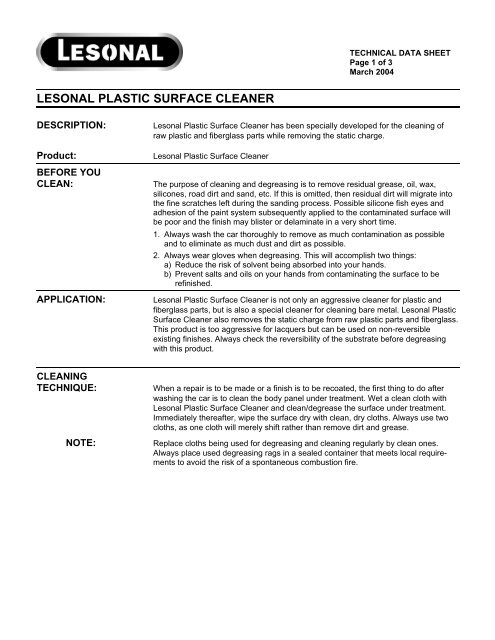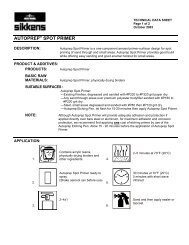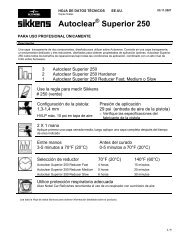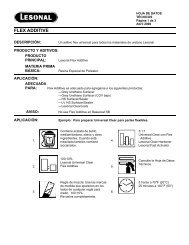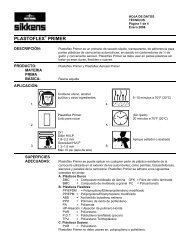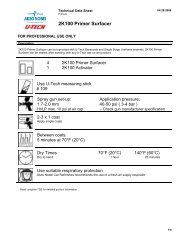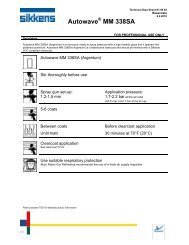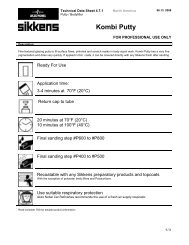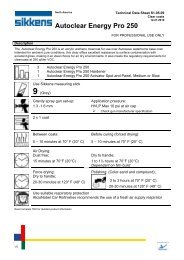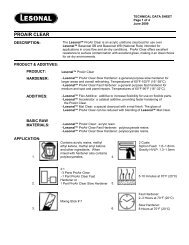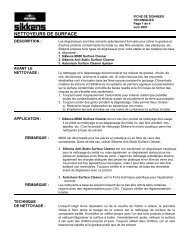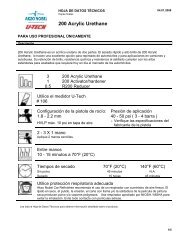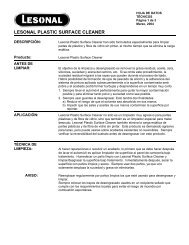LESONAL PLASTIC SURFACE CLEANER - Globalsafetynet.com
LESONAL PLASTIC SURFACE CLEANER - Globalsafetynet.com
LESONAL PLASTIC SURFACE CLEANER - Globalsafetynet.com
Create successful ePaper yourself
Turn your PDF publications into a flip-book with our unique Google optimized e-Paper software.
TECHNICAL DATA SHEET<br />
Page 1 of 3<br />
March 2004<br />
<strong>LESONAL</strong> <strong>PLASTIC</strong> <strong>SURFACE</strong> <strong>CLEANER</strong><br />
DESCRIPTION:<br />
Product:<br />
BEFORE YOU<br />
CLEAN:<br />
APPLICATION:<br />
Lesonal Plastic Surface Cleaner has been specially developed for the cleaning of<br />
raw plastic and fiberglass parts while removing the static charge.<br />
Lesonal Plastic Surface Cleaner<br />
The purpose of cleaning and degreasing is to remove residual grease, oil, wax,<br />
silicones, road dirt and sand, etc. If this is omitted, then residual dirt will migrate into<br />
the fine scratches left during the sanding process. Possible silicone fish eyes and<br />
adhesion of the paint system subsequently applied to the contaminated surface will<br />
be poor and the finish may blister or delaminate in a very short time.<br />
1. Always wash the car thoroughly to remove as much contamination as possible<br />
and to eliminate as much dust and dirt as possible.<br />
2. Always wear gloves when degreasing. This will ac<strong>com</strong>plish two things:<br />
a) Reduce the risk of solvent being absorbed into your hands.<br />
b) Prevent salts and oils on your hands from contaminating the surface to be<br />
refinished.<br />
Lesonal Plastic Surface Cleaner is not only an aggressive cleaner for plastic and<br />
fiberglass parts, but is also a special cleaner for cleaning bare metal. Lesonal Plastic<br />
Surface Cleaner also removes the static charge from raw plastic parts and fiberglass.<br />
This product is too aggressive for lacquers but can be used on non-reversible<br />
existing finishes. Always check the reversibility of the substrate before degreasing<br />
with this product.<br />
CLEANING<br />
TECHNIQUE:<br />
NOTE:<br />
When a repair is to be made or a finish is to be recoated, the first thing to do after<br />
washing the car is to clean the body panel under treatment. Wet a clean cloth with<br />
Lesonal Plastic Surface Cleaner and clean/degrease the surface under treatment.<br />
Immediately thereafter, wipe the surface dry with clean, dry cloths. Always use two<br />
cloths, as one cloth will merely shift rather than remove dirt and grease.<br />
Replace cloths being used for degreasing and cleaning regularly by clean ones.<br />
Always place used degreasing rags in a sealed container that meets local requirements<br />
to avoid the risk of a spontaneous <strong>com</strong>bustion fire.
TECHNICAL DATA SHEET<br />
Page 2 of 3<br />
March 2004<br />
<strong>LESONAL</strong> <strong>PLASTIC</strong> <strong>SURFACE</strong> <strong>CLEANER</strong><br />
UNTREATED<br />
<strong>PLASTIC</strong><br />
PARTS:<br />
1.<br />
Water<br />
Wash down the unpainted plastic part with<br />
warm water and detergent.<br />
2.<br />
Lesonal Plastic<br />
Surface Cleaner<br />
Wash down plastic part with Lesonal Plastic<br />
Surface Cleaner. The stronger solvent in<br />
Lesonal Plastic Surface Cleaner removes<br />
mold release agents.<br />
3.<br />
With a clean towel, dry off the Lesonal Plastic<br />
Surface Cleaner before it has time to<br />
evaporate. After this treatment, the surface is<br />
also rendered anti-static.<br />
NOTE:<br />
BARE METAL:<br />
4.<br />
20–30 minutes<br />
When cleaning unpainted plastic parts, allow<br />
the part to dry out for 20 to 30 minutes after<br />
the application of cleaner and before the<br />
application of a primer.<br />
The use of Autoclean Surface Cleaner must replace Lesonal Plastic Surface Cleaner<br />
in areas where the use of low VOC products is mandated.<br />
Lesonal Plastic Surface Cleaner can also be used on stable painted plastic parts.<br />
Follow the same procedure for unpainted plastic parts.<br />
Steel, zinc coated steel and aluminum should be degreased as follows:<br />
1.<br />
Lesonal Plastic<br />
Surface Cleaner<br />
Wash down the metal with Lesonal Plastic<br />
Surface Cleaner. This will ensure that the<br />
stubborn contaminants will be removed during<br />
final degreasing and cleaning.<br />
NOTE:<br />
2.<br />
With a clean towel, dry off the degreaser and<br />
cleaner before it has time to evaporate.<br />
—Always use one fresh towel for washing<br />
down and one fresh dry towel for wiping dry.<br />
—Replace towels regularly.<br />
With all cleaning and degreasing activities: once the vehicle has been cleaned, it must<br />
never be touched with the bare hand; as salts, moisture and oils can be transferred to<br />
the prepared surface which may result in adhesion or blistering problems. It is<br />
particularly important that hand protecting barrier creams are never used near an<br />
automobile that is to be refinished.
TECHNICAL DATA SHEET<br />
Page 3 of 3<br />
March 2004<br />
SPECIAL<br />
INSTRUCTION<br />
FOR CLEANING<br />
TRUCK BODY<br />
CONSTRUCTIONS:<br />
It is important to prevent dirt residues from getting into construction joints of vans,<br />
trucks, etc. during cleaning and degreasing. Disregarding proper cleaning of these<br />
areas may cause application and/or adhesion problems when the paint is applied.<br />
Vertical panels should, therefore, first be cleaned and degreased from the bottom<br />
upwards and subsequently from the top downwards.<br />
CLEANING AND<br />
CONDENSATION<br />
ON METAL<br />
<strong>SURFACE</strong>S:<br />
After a surface has been cleaned and degreased, the solvent will evaporate. The<br />
heat needed for evaporation is withdrawn from that surface, making it colder than<br />
the surrounding atmosphere, which results in (often not visible) condensation on<br />
the surface. Allow the moisture sufficient time to evaporate. The first coat of paint<br />
can be applied as soon as the surface has regained the temperature of the<br />
surrounding atmosphere. Earlier application of product may lead to adhesion<br />
problems.<br />
The same problem may arise if a vehicle is transferred from a cold room to a warm<br />
one, or from outdoors to indoors. Allow vehicles a minimum of one hour to<br />
acclimatize. Double-walled vehicles (and certainly insulated ones) require some<br />
hours to acclimatize.<br />
STOCK KEEPING:<br />
CONTAINER<br />
SIZE: Lesonal Plastic Surface Cleaner: 1 gallon (3.785 lt)<br />
SHELF LIFE:<br />
Two years if stored in original container at room temperature.<br />
SAFETY ASPECTS:<br />
VOC: Lesonal Plastic Surface Cleaner: 6.4 lb/gal 770 g/liter<br />
NOTICE:<br />
Do not handle until the Material Safety Data Sheets have been read and understood.<br />
Regulations require that all employees be trained on Material Safety Data Sheets for<br />
all chemicals with which they <strong>com</strong>e in contact. The manufacturer re<strong>com</strong>mends the<br />
use of an organic vapor respirator or air supplied respirator when exposed to vapors<br />
or spray mist.


